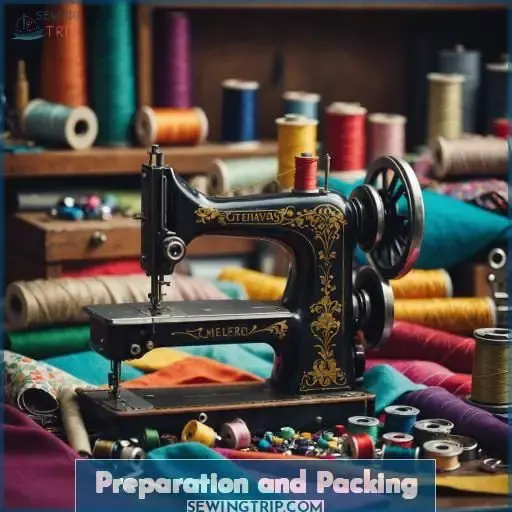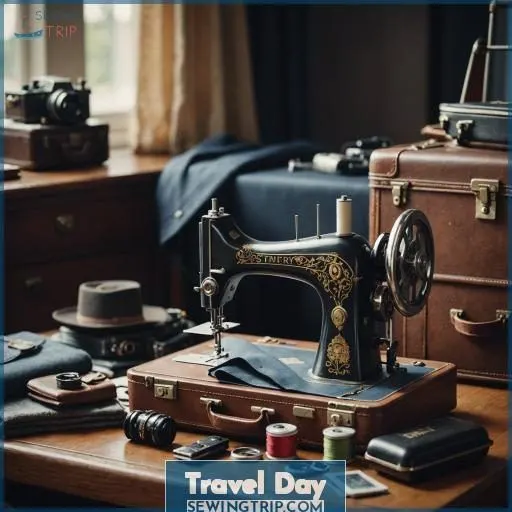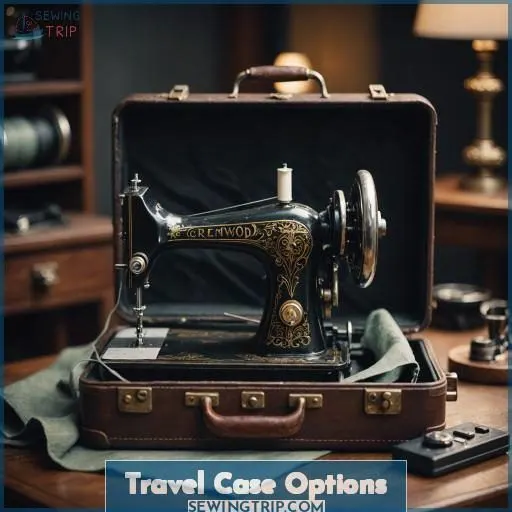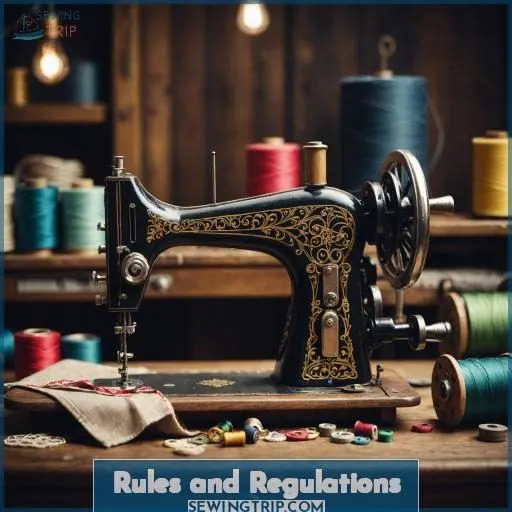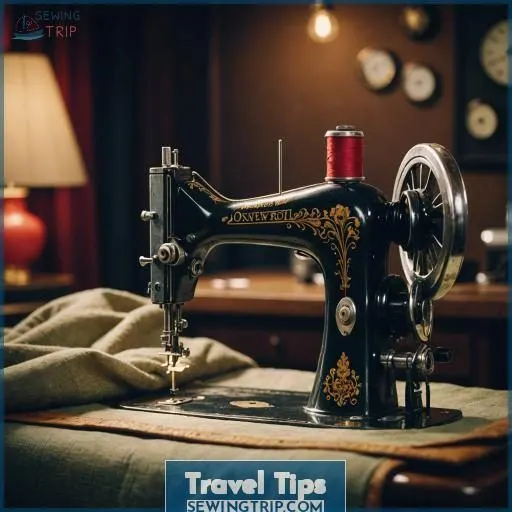This site is supported by our readers. We may earn a commission, at no cost to you, if you purchase through links.
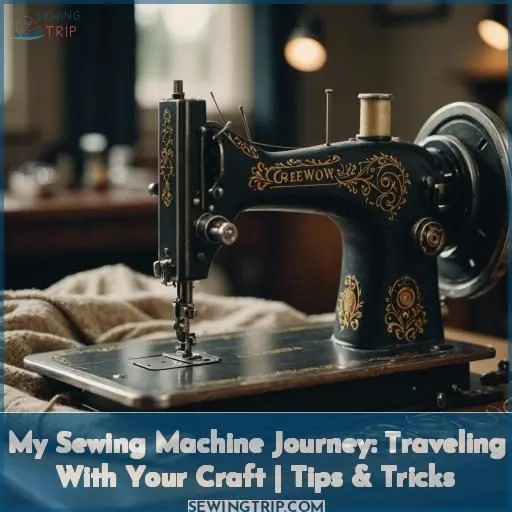 Your sewing machine journey requires careful preparation and packing. Lower the foot control for stability, remove sharp objects, and detach the foot pedal and cord. Consider bringing non-sharp tip scissors.
Your sewing machine journey requires careful preparation and packing. Lower the foot control for stability, remove sharp objects, and detach the foot pedal and cord. Consider bringing non-sharp tip scissors.
On travel day, pack your machine in carry-on or checked luggage, labeling checked items as fragile. Follow airline size and weight limits, using a rolling trolley if allowed. Research travel case options like the Tutto 20 bag or dedicated sewing cases.
Be mindful of rules and regulations, as most domestic machines meet size limits but weight can be tricky. By preparing properly, you’ll set yourself up for a smooth sewing machine journey. There’s more to explore when you dive deeper.
Table Of Contents
Key Takeaways
- Lower the presser foot for stability and remove any sharp objects, including screwdrivers, from your sewing machine before travel to ensure safety and compliance with airline regulations.
- Detach the foot pedal and power cord from your sewing machine to enhance safety and stability during transport, and consider packing scissors with a non-sharp tip to navigate security screenings easily.
- When deciding between carry-on or checked baggage for your sewing machine, consider the airline’s size and weight limits, and use a rolling trolley for easy transport if the weight allows.
- Explore travel case options like the Tutto 20 bag on wheels for durable and convenient transport of your sewing machine and accessories, keeping in mind the importance of adhering to rules and regulations regarding size and weight limits.
Preparation and Packing
To properly prepare and pack your sewing machine for travel, you’ll want to:
Lower the presser foot for stability.
Remove any screwdrivers or sharp objects that could pose a safety risk.
Additionally:
Don’t forget to detach the foot pedal and power cord.
Consider bringing a pair of scissors with a non-sharp tip to avoid any issues during security screenings.
Lower Foot for Stability
To guarantee your sewing machine’s stability during travel, lower the foot control before storing it away. This simple step helps prevent any unwanted movement or damage to the foot presser or tension dial. When packing, consider detaching the presser foot and placing it in the storage drawer to save space and meet weight limits.
Remove Screwdriver or Sharp Objects
Before beginning your sewing machine adventure, make sure to remove any screwdrivers or sharp objects from your hand luggage or checked baggage. This safety measure helps preserve the condition of your machine and complies with airline regulations.
Remove Foot Pedal and Cord
Before packing your sewing machine, make sure to remove the foot pedal and cord.
This step is vital for safety and stability during travel.
It’s also important to safeguard the cord and store it separately to avoid tangles.
TSA regulations may apply, so consult their guidelines for weight and size restrictions.
For instance, the Janome HD3000 and Juki HZL-355Z are portable options appropriate for travel.
Remember to pack rotary cutters and spare needles in your luggage.
Bring Scissors With a Non-sharp Tip
After unplugging your machine, consider packing scissors for travel. Opt for non-sharp scissor tips to navigate restrictions with ease, ensuring safety with scissors in your creative toolkit.
Travel Day
On travel day, you’ll need to decide whether to pack your sewing machine in your carry-on or checked baggage; if checking it, be sure to label the bag as fragile and treat it carefully. Observe the airline’s size and weight limits, and if the weight allows, consider using a rolling trolley for easy transport.
Pack Machine in Carry-on or Checked Baggage
When preparing your sewing machine for travel, you have two choices: carry-on or checked baggage. For carry-on, verify that it’s safely kept in a protective case and adheres to size restrictions. For checked baggage, utilize the original manufacturer’s box and mark it as fragile. Be aware of weight limitations, removing items from the storage drawer if required.
Label and Treat Checked Baggage as Fragile
When traveling with your sewing machine, it’s imperative to designate and handle checked baggage with care. This guarantees cautious handling and safe packaging, shielding your machine from damage during transit. Employ protective measures such as bubble wrap or a robust case to safeguard your valuable possession.
Follow Airline Size and Weight Limits
Packing Tips for Traveling with a Sewing Machine
To maintain the integrity of your sewing machine during travel, adhering to airline size and weight restrictions is essential. Here are some recommendations for packing your sewing machine:
- Carry-on or Checked Luggage: Evaluate the size and weight of your sewing machine to determine if it can be carried on or should be checked in. Smaller, portable sewing machines are often more convenient for carry-on. However, verify that it isn’t excessively large or heavy.
- Original Packaging: If checking in, secure a durable case to safeguard the machine from impact and mishandling. Utilize the machine’s original foam and box for maximum protection.
- Weight Limitations: Domestic sewing machines typically meet size limits, but weight limits can be challenging. Be cognizant of these constraints when deciding whether to carry on or check in your machine.
- Compact Travel Sewing Machine: Consider using a compact travel sewing machine such as the Juki HZL-355Z, which is designed for portability.
- Protection: A hard case is preferable, particularly if you travel frequently. Ensure that the case fits your machine securely to prevent movement during transit.
Use Rolling Trolley if Allowed by Weight Limits
When packing your sewing machine for travel, consider using a rolling trolley if it fits within the weight limits. This wheeled suitcase allows for easy transport of your machine, making it a convenient choice for those who want to carry their craft with them.
Travel Case Options
For traveling with your sewing machine, the Tutto 20 bag on wheels is an excellent option, providing a durable, padded case designed specifically for transporting machines and accessories. Various other dedicated sewing machine cases are also available from brands like Tutto, Janome, and Singer, offering customizable compartments and features like telescoping handles and inline skate wheels for smooth portability.
Tutto 20 Bag on Wheels
Regarding the matter of protecting your sewing machine during travel, the Tutto 20 bag on wheels emerges as your valiant protector.
This mobile stronghold harmoniously fuses case-like safeguards with the effortless weight management of a trolley.
Its robust bag wheels gracefully navigate airports, ensuring the safety of your invaluable cargo.
In the vast landscape of case alternatives, it distinguishes itself through its unwavering blend of durability and aesthetic appeal.
Other Sewing Machine Cases Available
Regarding the protection of your sewing machine during travel, you have numerous alternatives at your disposal. Soft cases and hard cases each possess unique advantages, contingent upon your requirements and fiscal constraints.
Soft Cases
- Soft cases are frequently more economical and can be more manageable to transport, particularly for diminutive machines.
- They can be tailored to accommodate specific dimensions and fabrics, rendering them adaptable to diverse applications.
- Soft cases are commonly employed in sectors such as electronics, industrial production, construction, music, and commercial packaging.
Hard Cases
- Hard cases provide enhanced durability and safeguarding, making them optimal for machines necessitating additional protection during transportation.
- They can be more costly but often merit the investment for tranquility.
- Hard cases are frequently used in industrial applications where heavy-duty protection is indispensable.
Brand Recommendations
- Custom Carrying Cases: Offers an array of soft case options for varying industries and applications.
- Sewing Parts Online: Supplies a spectrum of sewing machine cases, encompassing wheeled bags and totes.
- SBC Case Industries: Specializes in carrying case solutions for various industries, including custom carrying cases.
Rules and Regulations
When embarking on a journey with your sewing machine, it’s essential to acquaint yourself with the size and weight parameters established by various transportation providers.
While the majority of domestic sewing machines adhere to the dimensional constraints, the weight limitations can be problematic.
For example, the Juki HZL-355Z is a diminutive travel sewing machine meticulously crafted with portability in mind.
It renders it an optimal option for expeditions on foot, by bicycle, or via train.
Size and Weight Limits Vary by Travel Provider
Size and weight limits vary by travel provider, so it’s essential to check these restrictions before packing your sewing machine. Personal carry-on is generally safer than checked baggage, but size and weight limits apply to both. Baby machines can be carried on personally, while checked baggage should be labeled as fragile.
Most Domestic Sewing Machines Meet Size Limits
Most domestic sewing machines meet size limits, but weight can be challenging. Verify bag weight, machine specifications, efficient packing, needle storage, and case sturdiness align with airline regulations.
Weight Limits Can Be Tricky
When traveling with your sewing machine, weight limits can be tricky. To make certain your equipment is safe and compliant, consider these packing strategies:
- Remove unnecessary parts like the needle and foot pedal.
- Use a travel case for added protection.
- Follow TSA regulations and airline weight limits.
- Distribute weight evenly to avoid exceeding limits.
- Label and treat checked baggage as fragile.
- Consider a compact machine like the Juki HZL-355Z for portability.
Juki HZL-355Z is a Compact Travel Sewing Machine
The Juki HZL-355Z excels in mobility, a featherweight warrior making travel effortless. Its diminutive size guarantees practicality, fitting seamlessly in overhead storage.
Portability is Important for Foot, Bike, and Train Travel
Portability is essential for foot, bike, and train travel. Pack your machine in a carry-on or checked baggage, label it as fragile, and adhere to airline size and weight restrictions. Bring small scissors with a dull tip, detach the foot pedal and cord, and contemplate using a rolling trolley if weight restrictions permit.
Travel Tips
When traveling with your sewing machine, you’ll want to opt for carry-on over checked baggage whenever possible. After all, your trusty machine is safer in your own hands – and you can even bring along a compact baby machine right in your carry-on.
Carry on is Generally Safer Than Checked Baggage
When traveling with your sewing machine, it’s essential to comprehend the distinctions between carry-on and checked baggage. While carry-on is typically more secure, checked baggage can be more hazardous due to possible mishandling. To safeguard your machine, make certain to label and treat checked baggage as delicate. If feasible, store your machine in its original manufacturer’s box and packaging.
For personal carry-on, make sure your sewing machine conforms to size restrictions and refrain from bringing sharp objects or tools.
Baby Machines Can Be Carried on Personally
Concerning traveling with your sewing machine, you’ll want to make certain you’re following the right guidelines to secure a smooth journey. Here are some tips for carrying your baby machine as a personal item:
- Check carry-on restrictions: Some airlines have specific rules about what can be carried in the cabin, so it’s vital to know these beforehand.
- Pack smart: Make sure your machine fits within the dimensions of hand luggage or an overhead bin.
- Be prepared: Remove any sharp objects or tools from the machine to avoid any issues during security checks.
- Label and treat with care: Label your bag as fragile and treat it with extra care to prevent any damage.
- Follow weight limits: Keep in mind that weight limits for personal items can vary, so be aware of these before packing.
Frequently Asked Questions (FAQs)
What is the best sewing machine for a beginner?
As a beginner, you’ll love a versatile mechanical sewing machine like the Singer Heavy Duty Its powerful motor and 23 built-in stitches make it a breeze to tackle any project, from hemming to quilting. Stitch with confidence!
How do I properly store my sewing machine to prevent damage?
Safeguard your sewing soul, partner! Tuck that trusty machine into its custom-fit case, remove the needle, and let it rest easy. With the right prep, your workhorse will be rarin’ to sew another day.
What are the best materials to use for sewing beginners?
For sewing beginners, start with cotton fabrics like quilting cotton or muslin. They’re inexpensive, forgiving, and perfect for practicing techniques. Denim or leather can wait until you’ve built up some skills. Trust the process – it’s all part of the journey!
How can I improve my sewing skills quickly?
Don’t be shy – dive right in! Start with simple projects, celebrate your victories, and learn from mishaps. Consistent practice and an open mindset are keys to rapidly improving your sewing skills. You’ve got this!
What are some common mistakes to avoid when sewing?
Ah, young grasshopper, heed these words: never let your bobbin run dry, lest you face the dreaded thread jam! And for goodness sake, keep those pesky fingers away from the needle – you’re not trying to learn origami, are you?
Conclusion
Egads, by following these prudent steps, your sewing machine journey will be a breeze! Properly preparing and packing your machine, exploring travel case options, and understanding airline rules will guarantee a smooth experience.
Whether you’re hopping on a plane, train, or pedaling your bicycle, your trusty sewing companion can accompany you. With a bit of forethought, your sewing machine journey will be a delight, not a distress.
So take heart, fellow sewist, and bon voyage on your sewing machine journey!

